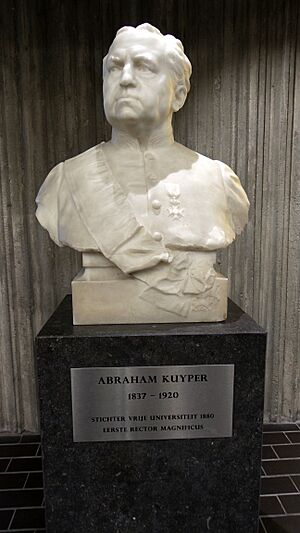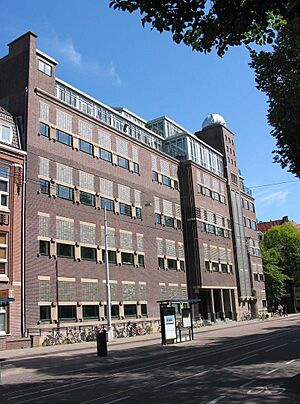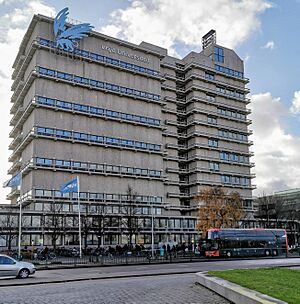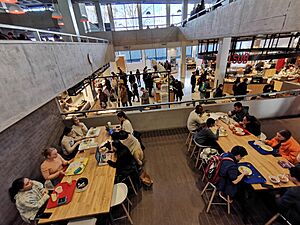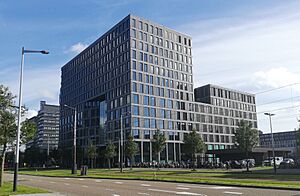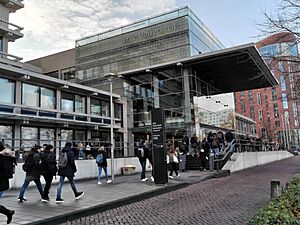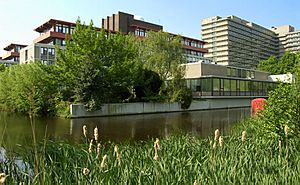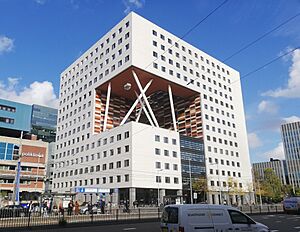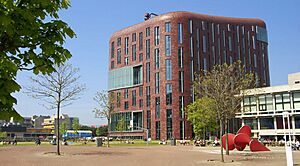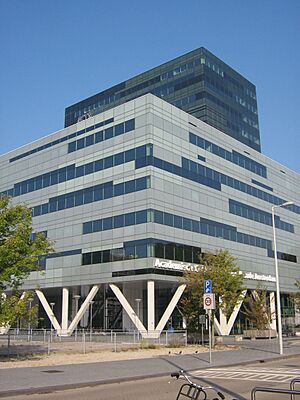Vrije Universiteit Amsterdam facts for kids
|
Vrije Universiteit Amsterdam
|
|
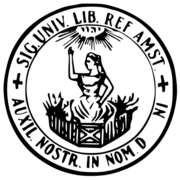
Seal: Maiden in the Garden
|
|
| Latin: Universitas Libera (Reformata Amstelodamensis) |
|
| Motto | Auxilium nostrum in nomine Domini (Latin) |
|---|---|
|
Motto in English
|
Our help is in the name of the Lord |
| Type | Public |
| Established | 1880 |
| Endowment | € 482.6 million |
| President | Margrethe Jonkman |
| Rector | Jeroen Geurts |
|
Academic staff
|
2,976 (2.263 fte) |
|
Administrative staff
|
1,662 (1,410 fte) |
| Students | 29,796 |
| Location | , , |
| Campus | Urban |
| Newspaper | Advalvas (Independent) |
| Colors | VU Blue and Black |
| Affiliations | Aurora EUA Santander AACSB |
 |
|
The Vrije Universiteit Amsterdam (often called VU Amsterdam or just VU) is a public research university in Amsterdam, Netherlands. It was started in 1880. The VU Amsterdam is one of two big public universities in the city. The other is the University of Amsterdam (UvA).
The name Vrije Universiteit means "Free University." This means it was independent from both the government and the church. Even though it started as a private school, the VU has received money from the government since 1970. The university is in a busy part of Amsterdam called Buitenveldert. It is also close to the modern Zuidas business area.
As of October 2021, the VU had almost 30,000 students. Most of them studied full-time. That year, the university had over 2,200 teachers and researchers. It also had more than 1,400 staff members who helped with administration and other tasks. The university's official symbol is called The Virgin in the Garden. It shows a maiden pointing to God. This symbol refers to the Protestant Reformation in the Netherlands. In 1990, the university started using the mythical griffin as its common symbol.
Contents
History of VU Amsterdam
How the VU Began (1880)
The VU was started in 1880 by a group of people called Calvinists. Their leader was Abraham Kuyper. It was the first Protestant university in the Netherlands. Kuyper was a theologian, a journalist, and a politician. He was even the prime minister of the Netherlands from 1901 to 1905.
Kuyper was also a professor at the VU. He was the university's first rector magnificus, which is like the academic president. His ideas are called Neo-Calvinism. The name Vrije Universiteit means 'Free University'. This showed it was free from both the government and the church. Teaching at the VU started in 1880 in a few rented rooms. These rooms were in the Scottish Missionary Church in Amsterdam's city center. Kuyper and four other professors began teaching three subjects: theology, law, and arts.
Growing Bigger (1900s–1960s)
By 1884, the Scottish Missionary Church was too small. The university bought its first own building. It was located at Keizersgracht 162. Over the next few years, the university bought more buildings around the city. In 1905, the VU was officially recognized. This meant it could legally give out university degrees. New subjects were added, like science in 1930 and medicine in 1950.
Money for the university came from the VU Association. This group was started by Abraham Kuyper. It was strongly connected to the Calvinist community. By the late 1960s, over 200,000 people were giving money to the university. Many gave small coin donations. About 10,000 people, mostly women, collected these donations. They went door-to-door with green VU collecting boxes.
Changes Over Time (1970s-2000s)
In the late 1960s and 1970s, the university changed a lot. From 1968, the university moved from Amsterdam's city center. It went to a new, modern campus in the Buitenveldert neighborhood. To make research stronger, the university decided to ask for public money. This money would be the same as what public universities received. This was allowed by the Dutch constitution. The university also stopped saying no to non-Protestant teachers and students.
Because of these changes, the number of students grew a lot. Students around the world were also asking for more say in how universities were run. New student groups formed at the VU. They wanted a more democratic way of doing things. By the end of the 1970s, the small, Christian university had become a big research university. It was open to students from all backgrounds.
More Growth and Updates (2000s–Present)
The number of students kept growing fast in the 21st century. It went from about 15,700 students in 2002 to 25,000 in 2011. This growth caused some problems. Students were less happy, and there were money issues. The university started a plan to make things better. This included updating campus buildings and making some changes to how staff worked. These changes sometimes led to disagreements with staff and students.
Life at the VU Campus
Exploring the Buitenveldert Campus
The main campus and medical center are in the Buitenveldert area of Amsterdam. The campus is about 0.4 square kilometers. It is built along a big road called 'De Boelelaan'. This area used to be mostly fields. Now, it is next to the modern Zuidas business district. This district has many large banks and law firms. You can get to the VU campus by metro line 51, tram lines, and bus routes. It is also a short walk from the Amsterdam Zuid railway station.
The university's Main Building ('Hoofdgebouw') was built in 1973. It is at the corner of the Boelelaan and Buitenveldertselaan. In the early 2010s, this sixteen-story building was greatly updated. The Main Building has faculties for Arts, Social Science, Philosophy, Economics and Business, and Theology. The University Library takes up five floors. The Main Building also has the main auditorium, a university restaurant, and a bookstore.
On the south side, the Main Building leads to the campus square. Many student groups have their offices here. South of the square is the Sciences Building ('Wis- en Natuurkundegebouw'). This building houses the faculties of Sciences and Earth and Life Sciences. In the middle of the campus square is The Basket, which is the university bar. There are also volleyball fields. Newer additions include a campus supermarket and an Italian coffee shop. Next to the campus square is the Institute for Health and Wellness. It is nicknamed the Red Potato because of its unique shape and color.
The Initium Building is along the Buitenveldertselaan. It houses the Faculty of Law. This arch-shaped building opened in 2010. It is now the eastern entrance to the VU campus. The Faculty of Social Sciences is in the Metropolitan Building. This building is just off-campus. The medical faculty is on the west side of campus. It is next to the large Amsterdam UMC, which is the VUmc location.
In 2018, the New University Building opened. It has spaces for teaching and research. It also has two cafes, an exhibition area, and a film screening room.
The Uilenstede Satellite Campus
The 'Uilenstede' campus is further south in Amstelveen. Uilenstede was built mostly between 1966 and 1970. It has many student housing buildings and the VU Sports Centre. It also has a campus cafe. Some of the university's administrative offices are at Uilenstede. You can reach Uilenstede by tram 25 and tram 5. Many of the student homes at Uilenstede are being updated. A new apartment building for visiting staff and international PhD students opened in 2012. This new building won an architecture prize. A big update of the public areas started in September 2013. This included building three new squares on the campus.
How the University is Organized
The Vrije Universiteit has several faculties. These faculties are in charge of teaching and research. There are also special research institutes that work across different subjects. As of 2015, after some faculties joined together, they include: Behavioural and Movement Sciences; Dentistry; Earth and Life Sciences; School of Business and Economics; Humanities; Law; Sciences; Social Sciences; Theology; and the VUmc School of Medical Sciences.
The Vrije Universiteit is a private institution. It is part of the VU-VUmc Foundation. The other main part of this foundation is the VU University Medical Center. This medical center has its own management.
The university is run by the Executive Board. This board has a president, a vice-president, and a rector. The Executive Board manages the university. It also chooses the deans and professors for the faculties. The Executive Board reports to a Supervisory Board. This board is chosen by the VU Association. The VU Association is the private group that started the university in 1880.
The university also has a Works Council. This group has elected representatives of teachers and staff. The Student Council also has a say in some university decisions. The College of Deans includes all the faculty deans. It is led by the rector. This group helps coordinate things at the university. It is also responsible for giving out doctoral degrees.
What You Can Study at VU Amsterdam
Teaching is organized within the different faculties. Together, the faculties offer 50 bachelor's programs. They also offer almost 160 master's programs. There are also many PhD programs.
Most bachelor's courses are taught in Dutch. As of fall 2015, the university offers five bachelor's programs entirely in English. These include Business Analytics, Computer Science, International Business Administration, Liberal Arts and Sciences, Literature and Society, and Philosophy, Politics and Economics. In fall 2018, the English-taught Bachelor program History and International Studies also started. The university-wide VU Honours Programme is also taught in English.
Over 130 master's programs at VU are taught completely in English. In some master's programs, there are many more international students than Dutch students. The university also has agreements with foreign universities. These allow foreign students to study at the Vrije Universiteit for one or two semesters.
Like all public universities in the Netherlands, students pay tuition fees. These fees are set by law. For the 2015/2016 school year, regular tuition fees were about €1,951 per year for students from the European Union or European Economic Area. For students from other countries, fees were €9,000 to €12,000 per year. Most Dutch students can get government loans or grants. These help cover tuition and living costs.
PhD programs are different. Students do not apply to the university directly. Instead, they must find a professor who has a spot for a PhD student. These students are called 'promovendus'. Most faculties list open positions on their websites. PhD students are paid a salary and are considered university employees. This means they do not pay tuition.
University Rankings
| University rankings | |
|---|---|
| Global – Overall | |
| ARWU World | 151–200 (2024) |
| CWUR World | 149 (2022–23) |
| CWTS World | 68 (2022) |
| QS World | =194 (2026) |
| THE World | =136 (2025) |
| USNWR Global | 78 (2025) |
Universities are often ranked to see how they compare globally. In the CWUR - World University Rankings for 2019–2020, the Vrije Universiteit was ranked 146th in the world.
In the 2023 Times Higher Education World University Rankings, VU was ranked 121st. For Arts and Humanities, the VU was 87th in the world. For Social Sciences, it was 81st. The VU also made it into the top 100 for Business and Economics (91st), Computer Science (96th), Law (91st), and Psychology (49th).
The 2023 QS World University Rankings placed the Vrije Universiteit 214th overall. This ranking looks at surveys from academics and employers. The VU was in the top 50 for Sport-Related subjects (23rd), Theology (32nd), Philosophy (34th), and Psychology (43rd). It was also in the top 100 for Pharmacy and Pharmacology (80th), Medicine (81st), Economics and Business (86th), Communication Sciences (51-100), Geography (51-100), and Anatomy (51-100).
The USNWR ranking of global universities placed the VU 84th in the world. It performed well in Economics and Business (44th), Clinical Medicine (58th), Social Sciences and Health (35th), and Arts & Humanities (102nd).
The CWTS ranking, which focuses on how often research is cited, placed the VU 79th in the world.
The 2021 Shanghai ranking placed the Vrije Universiteit in the 101–150 range overall. It had higher rankings in Communication (12th), Psychology (22nd), Geography (26th), Law (29th), Nursing and Dentistry (36th and 38th), Public Administration (42nd), and Economics (45th). Other fields in the top 100 included Political Science (76-100), Medicine (76-100), Sociology (76-100), and Business Administration (76-100).
The Tilburg University Top 100 Worldwide Economics Schools Research Ranking for 2016-2020 placed the Vrije Universiteit 39th in the world.
Research at VU Amsterdam
Research at VU is mostly done within the ten faculties and their departments. The university has four main areas of research focus:
- Human Health and Life Sciences: Studying health and living things.
- Science for Sustainability: Researching natural resources and how humans affect the environment, like climate change.
- Connected World: Looking at how information technology changes society.
- Professional Services: Focusing on business and finance, and topics like being a responsible company.
Besides faculty research centers, the university has several research institutes that combine different subjects. The Amsterdam Institute of Molecules, Medicines and Systems (AIMMS) was started in 2010. It has 17 research groups. These groups study pharmaceutical sciences, life sciences, and molecular sciences. AIMMS focuses on understanding how biological processes work. They also design new molecules and medicines. They also work on Biomarkers and diagnostics. The Vrije Universiteit Amsterdam School of Business and Economics is also part of the Tinbergen Institute. This institute works with Erasmus University and University of Amsterdam for economics and finance research.
In 2012, almost 3,000 academic staff worked at VU. About 42% were female. Almost 80% were from the Netherlands. About 15% were from other European countries. The rest came from Asia, North America, Africa, South America, and Oceania. About 29% of the academic staff were PhD students. In 2012, about 300 PhD dissertations were completed at VU.
In 2012, the European Research Council gave grants to VU researchers. The Netherlands Organisation for Scientific Research also gave grants. In 2013, Professor Piek Vossen (Computational Lexicology) won the Spinoza Prize. This is the highest science award in the Netherlands.
The University Library has a large collection of over 1,000,000 printed items. The library is on five floors in the university's Main Building. The medical collection is at the VU University Medical Center. The library's special collections department has 70,000 old manuscripts and printed items. Important collections include works from the Reformation and original English prints.
University Newspaper: Ad Valvas
The university has its own independent newspaper called Ad Valvas. It has been printed since 1952. The newspaper officially became independent in 1979. Ad Valvas used to come out every week. In fall 2012, it became a magazine published every two weeks. The Ad Valvas magazine focuses on longer stories, interviews, and opinion pieces. Daily campus news is mostly on the newspaper's website.
Ad Valvas is published every Thursday during the school year, 36 times a year. From 1994 to 1999, Frank van Kolfschooten was the main editor. In 2008-2009, about 12,226 copies were printed.
Well-Known People at VU Amsterdam
Notable Faculty Members
Many talented people have taught at the VU. Here are a few:
- Fons Trompenaars: An expert in how different cultures communicate in business.
- Henri Bal: A computer science professor who helped create a program that solved the game of Oware.
- Dorret Boomsma: A professor of biological psychology and a winner of the Spinozapremie.
- Mark van Vugt: A professor of evolutionary psychology.
- Brad Bushman: A visiting professor who is an expert on why people act aggressively.
- Jaap Doek: A law professor and former chairman of the U.N. Committee of the Rights of the Child.
- Carolyn Fischer: An economics professor who studies climate policy.
- Frank van Harmelen: An Artificial Intelligence professor who helped design the Web Ontology Language (OWL).
- Peter Nijkamp: A professor of spatial economics and a winner of the Spinozapremie.
- Piet Rietveld: An economics professor who researches transport economics.
- Andrew S. Tanenbaum: A computer science professor who created the MINIX operating system. This system inspired Linux. He has written many popular textbooks.
- Richard Tol: An economics professor who studies the economics of climate change.
- Pier Vellinga: The director of the Climate Centre.
Notable Past Faculty Members
- Jan Peter Balkenende: Was a professor and later the Prime Minister of the Netherlands.
- Herman Bavinck: A theologian.
- Jet Bussemaker: Was a professor and later the Minister of Education, Culture and Science.
- Herman Dooyeweerd: A philosopher of law.
- Pieter Sjoerds Gerbrandy: Was a law professor and Prime Minister during World War II.
- Martin L. Kersten: A computer science professor who helped create one of the first column-oriented databases.
- Pieter Kooijmans: Was a law professor and a Judge on the International Court of Justice.
- Abraham Kuyper: The founder of the VU and a Prime Minister of the Netherlands.
- Ronald Plasterk: Was a professor of molecular biology and later a minister in the government.
- Andrew S. Tanenbaum: A computer science professor who created the MINIX operating system.
- Jelle Zijlstra: Was an economics professor and later the Prime Minister of the Netherlands.
Notable Alumni (Former Students)
Many people who studied at the VU have gone on to do amazing things:
- Christine Aaftink: A national champion in speed skating.
- Jan Peter Balkenende: A former Prime Minister of the Netherlands.
- Wouter Bos: A former party leader and Minister of Finance of the Netherlands.
- Ellen van Dijk: A multiple cycling World Champion.
- Piet Hein Donner: A former Minister of Justice.
- Herman Dooyeweerd: A philosopher who also taught at the VU.
- Pim Fortuyn: A politician.
- Frits Goldschmeding: The founder of Randstad NV, a large staffing company.
- Nico Habermann: A well-known computer scientist.
- Frans Kaashoek: A computer scientist and professor at Massachusetts Institute of Technology.
- Bert Koenders: A former Minister of Developmental Cooperation.
- Linda de Mol: A famous Dutch and German TV host and actress.
- Atzo Nicolaï: A former Minister of Government Reform.
- Nico Rienks: A double Olympic Champion in rowing.
- André Rouvoet: A former Minister and Vice-Prime Minister.
- Paul-Peter Tak: An immunologist and executive at GSK.
- Eberhard van der Laan: A former mayor of Amsterdam.
- Werner Vogels: The Chief Technology Officer and Vice President of Amazon.com.
- Dilan Yeşilgöz-Zegerius: The current Minister of Justice and Security.
- Gerrit Zalm: A former Minister of Finance and CEO of ABN AMRO.
Images for kids
See also
 In Spanish: Universidad Libre de Ámsterdam para niños
In Spanish: Universidad Libre de Ámsterdam para niños
- Hortus Botanicus Vrije Universiteit Amsterdam
- List of modern universities in Europe (1801–1945)
- List of rectores magnifici of the Vrije Universiteit Amsterdam
- VU University Medical Center (VUmc)


